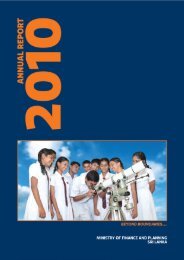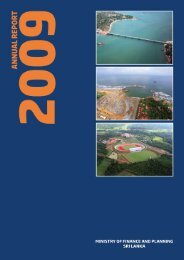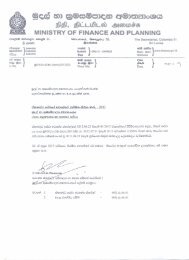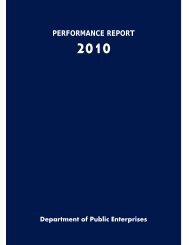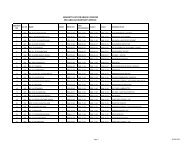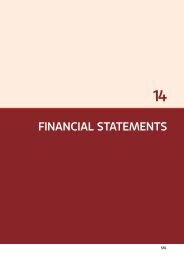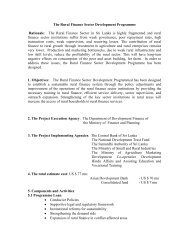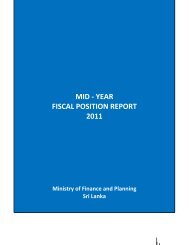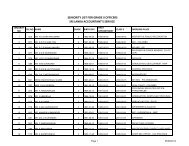Annual Report 2008 - Ministry of Finance and Planning
Annual Report 2008 - Ministry of Finance and Planning
Annual Report 2008 - Ministry of Finance and Planning
You also want an ePaper? Increase the reach of your titles
YUMPU automatically turns print PDFs into web optimized ePapers that Google loves.
2. Fiscal Developments - <strong>2008</strong><br />
46<br />
An Overview<br />
The fiscal strategy <strong>of</strong> the government in <strong>2008</strong> based on the<br />
Medium Term Macro Fiscal Framework, 2007-2010 was<br />
steered along to fulfill the desired targets in the backdrop<br />
<strong>of</strong> a very challenging environment stemming from the<br />
developments in the external <strong>and</strong> domestic fronts.<br />
was maintained at the same level as in 2007, reduced<br />
the recurrent expenditure as a percentage <strong>of</strong> GDP to 16.9<br />
percent from 17.4 percent in 2007 <strong>and</strong> maintained the public<br />
investment at 6 percent level for the fourth consecutive year<br />
in spite <strong>of</strong> the reduction in Government revenue from 15.8<br />
percent <strong>of</strong> GDP in 2007 to 14.9 percent in <strong>2008</strong>.<br />
The unprecedentedly high prices on food <strong>and</strong> petroleum<br />
products that prevailed in international markets warranted<br />
the Government to grant duty concessions on such items<br />
with a view to curb the rising domestic market prices,<br />
compressed the revenue flows in <strong>2008</strong>. Continued operations<br />
to liberalize Northern part <strong>of</strong> the country from the thrust<br />
<strong>of</strong> the terrorists, necessitated the Government to allocate<br />
funds for these activities while expediting the humanitarian,<br />
resettlement <strong>and</strong> development work in the Eastern Province<br />
<strong>and</strong> the newly liberated areas in the Northern Province.<br />
Priorities attached to the development work to achieve a<br />
regionally balanced economic development through rural<br />
development initiatives the “Gama Neguma”-”Jathika<br />
Saviya” <strong>and</strong> national infrastructure projects under “R<strong>and</strong>ora”<br />
programme, while maintaining the social safety net to<br />
protect the vulnerable groups <strong>of</strong> the society <strong>and</strong> the human<br />
resource development through better health <strong>and</strong> education<br />
systems also required additional resources. Amidst these<br />
external <strong>and</strong> domestic challenges, fiscal performance in<br />
<strong>2008</strong> produced mixed results.<br />
The revenue shortfalls arising from the granting <strong>of</strong> duty<br />
concessions coupled with the global financial crisis<br />
which intensified in the latter part <strong>of</strong> <strong>2008</strong> resulting in a<br />
slowing down <strong>of</strong> domestic economic activities, drying up<br />
<strong>of</strong> foreign investments for budgetary operations coupled<br />
with premature withdrawals <strong>of</strong> foreign investments on<br />
Government securities <strong>and</strong> increased funds required for<br />
fertilizer subsidy exerted pressure on budgetary operation<br />
in <strong>2008</strong>. These adverse developments caused deviations in<br />
the underlying assumptions <strong>of</strong> the <strong>2008</strong> Budget. Even in<br />
this background government was successful in maintaining<br />
public investments at 6 percent <strong>of</strong> GDP.<br />
With regard to fiscal consolidation effort, the overall<br />
budget deficit including the fully foreign funded projects<br />
The Government revenue effort was thwarted mainly due<br />
to revenue shortfalls which arose in external trade taxes<br />
stemming from granting duty concessions on motor vehicles<br />
for public servants <strong>and</strong> tax concessions granted on essential<br />
commodities to stabilize the domestic prices on such items.<br />
The effect <strong>of</strong> these concessions was felt throughout the year<br />
where the revenue forgone from these measures alone was<br />
around 0.7 percent <strong>of</strong> GDP. Consequent to these measures<br />
<strong>and</strong> economic slowdown in the backdrop <strong>of</strong> intensified global<br />
financial crisis in the latter part <strong>of</strong> the year, the government<br />
revenue as a percentage <strong>of</strong> GDP declined to 14.9 percent<br />
from 15.8 percent in 2007.<br />
Channeling enhanced funds to strengthen the national<br />
security, new recruitments to the armed services to protect<br />
the newly liberated areas, high international prices on<br />
fertilizer resulting in enhanced funds required for the<br />
fertilizer subsidy, revisions in domestic petroleum prices<br />
to mitigate the unprecedentedly high international prices<br />
creating over runs in the budgetary allocations in the fuel <strong>and</strong><br />
related expenditures, maintaining the welfare programmes<br />
for vulnerable groups in the society <strong>and</strong> high interest rate<br />
structure that prevailed during the year stemming from the<br />
tight monetary policy stance adopted by the Central Bank<br />
<strong>of</strong> Sri Lanka, exerted pressure on expenditure management.<br />
Even with these developments the Government maintained<br />
its high priority given to the development <strong>of</strong> infrastructure<br />
facilities in the lagging regions <strong>and</strong> implementation <strong>of</strong><br />
mega development programmes under the “R<strong>and</strong>ora”<br />
Infrastructure initiative. Sri Lanka recorded both highest<br />
commitment <strong>and</strong> the highest disbursement <strong>of</strong> foreign funds<br />
in <strong>2008</strong>. The gross disbursement stood at US $ 1,226 million<br />
while commitments <strong>of</strong> foreign funds during <strong>2008</strong> were US $<br />
2,067 million. The disbursement <strong>of</strong> foreign funds continued<br />
for projects such as Norochcholai Power Plant, Hambantota<br />
Port Development, Upper Kothmale Hydro Power Project,<br />
<strong>Ministry</strong> <strong>of</strong> <strong>Finance</strong> <strong>and</strong> <strong>Planning</strong> Sri Lanka<br />
<strong>Annual</strong> <strong>Report</strong> <strong>2008</strong>



